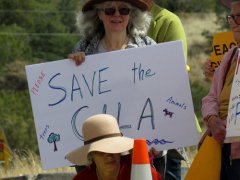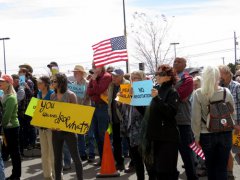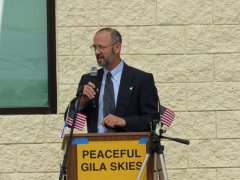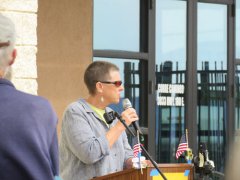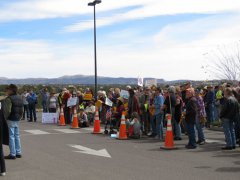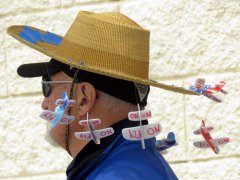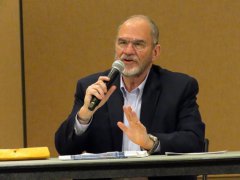Article by Mary Alice Murphy
Thanks to Sandy Feutz and Tom Vaughan of FeVa Fotos for sharing their photographs of the rally and session.
Air Force listens to input at flyover public meeting 030818
Air Force listens to input at flyover public meeting 030818
One of many protest signs outside the meeting. Photo by Sandy Feutz
Air Force listens to input at flyover public meeting 030818
Protestors at the rally preceding the presentation and input session. Photo by Sandy Feutz
Air Force listens to input at flyover public meeting 030818
Commissioner Harry Browne speaks against the proposed training flights over the Gila
Air Force listens to input at flyover public meeting 030818
County Assessor Raul Turrieta speaks his mind. Photo by Tom Vaughan
http://grantcountybeat.com/images/2018newsitems/FrontPageNews/AF-flyover-mtg-3-818/IMG_7805.jpg
Air Force listens to input at flyover public meeting 030818
Commissioner Alicia Edwards protests the flyovers Photo by Tom Vaughan
http://grantcountybeat.com/images/2018newsitems/FrontPageNews/AF-flyover-mtg-3-818/IMG_7817.jpg
Air Force listens to input at flyover public meeting 030818
The rally brought out lots of protestors Photo by Sandy Feutz
Air Force listens to input at flyover public meeting 030818
Another sign, but voting is everyone's super power Photo by Sandy Feutz
Air Force listens to input at flyover public meeting 030818
His hat expresses his opinion Photo by Sandy Feutz
Air Force listens to input at flyover public meeting 030818
A protestor doesn't want jets flying over the Gila Photo by Sandy Feutz
Air Force listens to input at flyover public meeting 030818
New Mexico Lt. Governor John Sanchez's Chief of Staff Mark Van Dyke presents at the beginning.
http://grantcountybeat.com/images/2018newsitems/FrontPageNews/AF-flyover-mtg-3-818/IMG_7823.jpg
Air Force listens to input at flyover public meeting 030818
Air Force Lead Airspace Analyst Alan Shafer answers a question. Photo by Sandy Feutz
Alan Shafer, lead airspace analyst for the U.S. Air Force, came to Silver City on Thursday, March 9, 2018, at the invitation of New Mexico Lt. Governor John Sanchez.
Representing the Lt. Governor was Mark Van Dyke, chief of staff for Sanchez.
"We are seeking information from you for our process, because we felt Silver City should be included during the comment period," Van Dyke said. "Alan Shafer will give you information on the NEPA (National Environmental Policy Act) process and where we are."
Shafer thanked the Lt. Governor for prompting the meeting. "Holloman Air Force Base has a proposal to expand its training for F-16 pilots. Two areas, Alternative 1 and Alternative 2, are under consideration. You are in Alternative 2. The process to analyze the airspace is regulated by NEPA. We had three scoping meetings in population centers. We expected Silver City residents to attend one of the meetings. We are truly sorry the information about the scoping meetings did not get as far as we had hoped, so you didn't know about them."
[Author's Note: For much of the meeting, shouts from the about 400 people attending would drown out what the speakers were saying and particularly when some did not like what they were hearing from Shafer. Although they also drowned out some of their own speakers with yells of approval and applause.]
Shafer said the analysis of the air space is still in the beginning of the process. "We are not anywhere near knowing what the analysis will tell us. We are actually at the end of the beginning of the process. The Air Force is seriously looking at adding more localities to the public hearings. At the hearings, we will ask you to write down your comments and speak to the panel. We will have a court reporter taking down what you say at that time. We have already received more input from Grant County than from anywhere else. You can still be part of the process. Any comments received before the draft EIS (environmental impact statement) is released have to be considered. I am here as the subject matter expert."
Van Dyke asked Shafer who was doing the analysis. Shafer replied: "Cardno is doing the EIS on our behalf out of their Hampton, VA, office, although the company has offices all over the country and world."
The question phase of the meeting began.
A woman asked: "Do you have any idea of the damage you are doing to our lives with this proposal?"
Shafer replied: "We have seen no analysis. The Air Force doesn't own the sky. The administration of airspace is by the Federal Aviation Administration."
Van Dyke cautioned that the purpose of the meeting was to talk about the use of airspace. "The process is addressing the EIS process."
"There has been special use of airspace since the 1950s," Shafer said. "It was designed for aircraft that are no longer in use. The F-16s of today are different from ones flown before. We are optimizing the existing airspace. This area is a reasonable area for analysis."
Van Dyke emphasized that the Air Force will "absolutely be certain that any subsequent meetings will be publicized for people in Grant County."
A questioner asked Shafer: "Have you ever hiked in the Gila Wilderness?" Shafer replied: "Not yet." A follow-up question asked: "Is your analyst going to come and hike in the Gila Wilderness?"
"I'm pretty sure Secretary of the Air Force (Heather) Wilson has been here," Shafer replied.
The same man continued. "The Air Force did me a favor by stationing me in New Mexico. In 1970, I came here with other officers. They invited me to hike here in the Gila Wilderness. It needs to be protected. This is a lousy idea to fly over the nation's first wilderness. I recommend you go back and rethink this idea. I'm a pilot. I have flown over what will be the floor and the ceiling of the MOA (military operations area). If you use this airspace for training, I won't be able to fly to Farmington without going around by I-25. I have to fly at 2,000 feet. It's insane for you to propose flying at 500 feet. It will impact archaeological ruins. Have you gone to Catron County, which will also be impacted? You went to Las Cruces and other places, but not here."
Shafer said under the notice of intent in the Federal Register, it says the intent is to develop the airspace from 500 feet to 18,000 feet and above that to 50,000 feet. "We are looking at the airspace. We are aware of the Gila National Forest and Wilderness and its importance. About 10 percent of the flights will be supersonic. Yes, the human environment will be evaluated."
A child said: "It will affect children, who wouldn't be able to get to school."
Shafer said human impact will be evaluated.
A man said he has lived in New Mexico for 30 years and has hunted and fished throughout the state. "I'm curious if the contractor has considered hunting and angling. About $6.5 million comes to the state for angling. Anglers spend more than 100,000 hours fishing. We have 38,000 hunter days. The flights will have an impact on the economy."
Shafer said under the NEPA, those impacts will have to be analyzed. "We ask you to post those numbers on our website."
Van Dyke later in the meeting read the website address, which is www.HollomanAFBairspaceEIS.com. He encouraged anyone with facts and figures to take advantage of the website opportunity to comment.
A man said he believes the FAA strongly suggests that no airplane fly less than 2,000 feet over the highest land in an area.
"I will try to answer for the FAA," Shafer said. "It has airspaces down to AGL (above ground level) and even to the surface. Please look at the national defense strategy, which notes potential conflicts and enemies and why we have to fly. An FAA advisory circular (that he couldn't remember the number of) asks that pilots voluntarily avoid wilderness areas and national seashores."
A man shouted out that aeronautical charts recommend at least 2,000-feet altitude over such areas.
Another man, identifying himself as Paul Slattery, aggressively said: "Why should I believe a thing you say? You are underhanded and sneaky."
Van Dyke asked for respect, as Shafer attended at the state's request. "He felt he needed to come back again. Yes, it was last minute, but we felt it was better to get him here. We took a look at his schedule, and we reached out to add this meeting."
Shafer said the NEPA process is built to be open and transparent (to jeers from the audience). "When we have the hearings, you will have the opportunity to testify."
Elline Kingsley said her question was to the Secretary of the Air Force. "Why did you make this choice? What are the demographics that led to the decision to consider training over the Gila Wilderness? There is no enforcement possible for AGL. Why choose this alternative? Why it is mission critical? It is not rational."
Shafer said the draft EIS will show why it is a reasonable alternative. "I encourage you to attend the public hearings. I cannot answer that kind of question."
A man said it was all about distances—the distance from Alamogordo. "These areas fell in that distance."
Shafer said the distance from the base is critical because fuel consumption is important. The mission is to have new trainings for pilots. The distances considered were 90, 120 and 150 miles from Holloman AFB. "We used those rings. We are analyzing the areas within those rings. One to the north is Pecos-B. We are hoping to look at the analysis soon and come out with the draft EIS."
Lynda Aiman-Smith said she wanted to verify that it would be the Secretary of the Air Force or her designee who would make the decision.
"Yes, for the record of decision, the Secretary or her designee, would decide," Shafer said. "But the final, formal, final decision is by the FAA, and there are other cooperating agencies."
Aiman-Smith asked if there were a way to access the final criteria and a question of costs.
"We are trying to figure out other criteria," Shafer replied. "The main one is optimizing the use of the airspace. Cost will be part of the NEPA. We have the primary website for comment. Anything you hand to me is part of the administrative record."
A man said he bought a house in 1991 at the edge of the forest. "The Germans were flying over and rattled my house. I will be out there with a long-range rifle if they come over again."
Another man said the wilderness was his passion, his religion. "Why does Alamogordo get the economic benefits? Why does the government spend so much on militaries and not enough on health care and education? I guess I have no question."
Mary Hotvedt, who said she lives in Pinos Altos on the edge of the forest, thanked Shafer and the Lt. Governor for the meeting. Then she said: "I'm astounded it has taken you so long to listen to us. What will you take back from this meeting?"
"By a factor of 10, we have received comments from this area," Shafer repeated. "I understand how important the Gila National Forest and Wilderness are to you. We learn more about your concerns and they will be part of the analysis."
A man, named John, said he served eight years on a wilderness trail crew. "A huge segment of those interested in this issue are not here due to work and school. This is representational of the area by five or 10 times as many. I experienced a transformation working in the wilderness. I was being re-oriented to my consciousness of life. The Gila presents the opportunity to re-orient ourselves. It is the most comfortable, friendly wilderness in the country. How is NEPA going to incorporate the value of sanctuary and the sourdough starter of our consciousness?"
Shafer said it would be hard to equate. "It will be your words and thoughts. If, when the draft EIS is out, you don't believe it is strong enough, comment. Every comment has to be addressed. Ask those questions and they will have to be addressed."
A man said it was hard to quantify. "Will you agree with the impact of the overwhelmingly similar thoughts out of this county?"
Shafer said: "We are looking at a lot of comments. If we receive 3,000, 5,000, 10,000, it is recognized in the document."
Elizabeth Foster said it sounds like a NIMBY issue, "but, if you destroy the Gila, you have begun to continue something that will make it difficult to keep our planet alive. When your panel came last fall, we were reassured at how safe it would be and how nothing would happen. Why do you now have no answers?"
Van Dyke again asked for respect, when shouts and applause broke out.
"The safety of the use of chaff and flares will be analyzed," Shafer said. "The Air Force has done analysis on chaff and flares. I assure you, if we drop chaff and flares, it is because we believe in the safety of them."
A woman thanked Shafer for "being here. It is patriotic to be a dissenter. Many in my family served in the military. It is patriotic to dissent. Multiple times people have done things that were considered safe, but then discovered otherwise. The atomic tests led to cancer. Plastic beads are toxic. Yes, there is an analysis, but then there is the seventh-generation analysis. Please post more of the exact nature of the analysis. This proposal will cost wildlife lives. To what standard and where are you posting the analysis?"
"The analysis will have information that will cite scientific studies," Shafer said. "If you have other studies we can use, let us know."
"This is about halfway during our session," Shafer said. "We will come out for the public hearings. On the website, you can ask that a copy of the EIS be sent to you."
He gave the website again: www.HollomanAFBairspaceEIS.com
A man said he hoped Shafer would not take the hostility of the audience back with him. "We are passionate about our forest and wilderness. A couple of times a year, I see groups of jets flying low. I've never complained. But what is being proposed is bizarre. You wouldn't do it over the Santa Fe Opera or another wilderness. Go back with the facts, not with hostility, but realize you haven't treated Grant County well."
"It's not hostility," Shafer said. "It's you, communicating your passion. I want to learn more about the Gila. Under NEPA, we have to look at all reasonable alternatives. The draft EIS is the time for formal comments."
Dr. Michael Brown thanked Shafer for coming and listening. He said he has two types of cancer. "In the 1980s you stopped F-15 flights over the Gila. Now they are flying over Saudi Arabia. Will the F-16s be flying over other countries? I'm hoping the Air Force will make a reasonable decision. I think the military-industrial complex is war against humanity."
Todd Moore asked if Shafer was there as a NEPA expert.
"I am here at the request of the Lt. Governor and as an Air Force representative to talk about NEPA," Shafer said.
A man said the comment period is 30 days. "How will all these comments be considered in the impact study?"
Shafer replied: "The NEPA comment period is 30 days. We further accept every comment received. The NEPA does not supersede other decisions. The Air Force's regulations can be more restrictive."
Scott Terry, Chamber of Commerce director and manager of the Grant County Veterans Memorial Business and Conference Center where the event was held, said: "We have filled the parking lot. Ace Hardware customers are not able to shop because there are no spaces. I ask you, in respect, when this is over to go into Ace and buy something, even a stick of gum."
A woman said: "Just as you're saying it is difficult to quantify the value of the wilderness, is it also difficult to analyze the Gila Valley. Will you be able to play a sound, so we can hear what it sounds like when a jet roars 500 feet overhead? Aren't you the man who said you really liked the sound of jets?"
"I love airports," Shafer said. "I grew up going to air shows. I'm the wrong person to ask."
The same woman said she heard at the prior meeting from the Alamogordo Chamber of Commerce that they really like airplanes. "I didn't want to get out of bed, I'm so upset over this. I thought the Gila Wilderness designation protected us." She broke down in tears. "I can't think of any reason for this proposal to go through. Please don't come here. Do you know what designated wilderness means?"
"Everything else we will do in the EIS will comply with all federal laws," Shafer said.
Another child spoke. "Me and a friend go to the Gila Wilderness. Every day we catch crawdads. It's not a good idea to fly over us. Fly over your own property."
Shafer thanked the child for speaking. "We need young people to continue the process."
Jim Lee asked if the draft EIS would deviate from the EIS already posted in the Federal Register.
Shafer said when the notice of intent comes out and says what "we are intending to do, after the scoping, there may be additional alternatives. There is no draft EIS on our website."
Lee alleged the EIS has redacted the 2,000-foot altitude limit. "It does not show the 2,000-foot restriction over the Gila or Aldo Leopold wildernesses."
"I don't know what will be put in the draft EIS," Shafer said. "By late summer, we will have that information on altitude."
A woman said she has been unclear about the proposal from the beginning. "How the proposal is progressing, so I can better comment. Are you a member of the Air Force?"
"I am a 32-year veteran of the Air Force," Shafer said. "I am now a civilian employee of the Air Force."
Another woman asked for clarification on the contractor looking at the analysis.
"I, as an employee of the Air Force, am working with a contractor," Shafer said. "'We' is the Air Force and the contractor." To a question about his boss, he said he works under a retired Air Force officer, who is director of Air Force Headquarters, whose boss is an active duty colonel.
The same woman asked about the company gathering the data. "Can we know in detail what the contract with the Air Force says?"
Shafer said the contract is with another department, the Air Force Civil Engineering Center at Lackland AFB. "I don't know what is releasable on the contract."
The same woman said the map has an ellipse over the Gila region, but the others are not elliptical.
Shafer said the EIS will have a direct photo of the MOA. "The elliptical area is identifying the area that is a reasonable alternative."
The woman said she would like to know the scientific qualifications of those doing the analysis.
"The final EIS will have the names and qualifications," Shafer said. "They use scientific models. The people who work for the contractor work all over the country from the west coast to the east coast. It is a large group of scientists."
Jane Gillespie said she is a retired professor of microbiology. "The EIS takes about six months. That is not even a life cycle. Look back at the times when chaff was dropped to see what the impact was. It's hard to find that impact."
"There are lots of studies," Shafer said. "We will try to put some of those studies on the website."
A woman asked if small private planes were going to be safe.
"The FAA has the final, ultimate decision on that," Shafer said. "Its mission is the safety and efficiency of national airspaces. At the same time we are doing our public hearings, the FAA will be making comments on the draft EIS."
The woman asked if residences are included in restricted areas.
Shafer said: "Those flying under visual flight rules (VFR) are allowed to fly through restricted areas. IFR (instrument flight rules) are not allowed to fly through restricted areas. In VFR, nothing says they can't fly over areas. For military operations areas, they would refer to operational hours. As for residences, the FAA talks about minimum altitudes. They will look at the minimum altitudes and navigable airspace."
A woman, who said she is a member of the Upper Mimbres Volunteer Fire Department, directed her question at Van Dyke. "That fire department protects the southern edge of the Gila National Forest and Wilderness. It is protected by volunteers, most of whom are retired and some frail. Others are young and employed. We have very limited resources, but we do everything from house fires, leaky propane tanks, accidents. We don't know what we will face until we get there. Often, we are the first responders. What will the 600 jobs economic boom do to protect the residents who rely on volunteers, when the fires are from chaff and flares?"
"We don't know what it will look like," Van Dyke replied. "We are working with the information we have now. The airspace area for training could leave it as it is now, move it to the east or push it to the west. The state is not pushing in favor of any alternative. We do plan to have continued military presence in New Mexico. We do support the military, but we are not pushing for a particular plan. Yes, we are in favor of F-16s training here. The devil is in the details, and so is the right path forward."
He said there will be an economic impact for southwest New Mexico residents, and it may be educational opportunities.
As for how to protect with few resources, Van Dyke said: "There is no free choice here. There are concerns with any alternatives, but we support the mission of the F-16 trainings. We're investing in a process. That's why we asked Mr. Shafer to come here. If there is overwhelming data against flying over the Gila, it will be taken into consideration. The Legislature gave a tax break of $15 million in gross receipts tax for the expansion of Holloman. That wouldn't happen without this process."
A woman asked if Shafer knew anything about a wilderness area. "On the ground, you can't have a bicycle, but sonic booms can take place? How in the process is public comment weighted?"
"We start with a proposal, we develop alternatives and the comments from the public are considered," Shafer said. "I know how important the Gila is to this group and not only this group. If we were to proceed with this action, we would have reasons. These comments are weighted. When we do the public hearings, these comments have to be made again. It's helpful to have them on the website.
"We are seriously considering adding Silver City to the list of scoping locations," Shafer said. "I will be the first to hear the analysis. I know zero at this point. Your public officials are weighing your comments."
Kyle Johnson, who was recording the session, said: "Can I submit and be part of the record? We are also confronted with another issue. The sensitivity in this room and our lack of trust in government in general is caused by that. We are challenging the diversion of the Gila River. That is another major threat to the area and our place in it. Please bring to Gov. Martinez and ask her to comment publicly. We have problems with that also at the local level. The diversion is being promoted by the Office of the State Engineer and the Interstate Stream Commission and by local representatives here. I will use this opportunity to say that our confidence in the integrity of the federal, state and local government is being compromised. We are unhappy with government at the federal, state and local levels, because they are not transparent. I understand you are not the guy who decided. But this place was given significance by the federal government. It causes me to question your judgement. He quoted: 'Never attribute to malice that which can be explained by incompetence.'"
Joni Kay Rose shouted into the microphone: "I was hiking in the Burro Mountains with a friend. We got strafed. We were ducking. We felt like we were under attack. The dog was terrified. We saw no wildlife for an hour afterward. People, what about animals' hearing? Do we have to wear ear plugs to go hiking? If you fly over the wilderness, it destroys the concept of wilderness. How can it be wilderness, if we're being strafed? We have the Gila and Aldo Leopold wildernesses. What would Aldo do?"
A man talked about alternatives. "If you fly on the west side of I-25, you come to another national forest of 150,00 to 200,000 acres or more. The whole population there is fewer than in this room. Is that an alternative?"
Shafer said there is an alternative north of the Gila Wilderness. "It's part of the other alternative v."
Jene Mosely said she lives on the edge of the Gila National Forest. "I don't think you, the Forest Service or Heather Wilson has a clue about the fight you're in for."
Nick Sussillo, former Air Force officer, said on the EIS website is a matrix, with criteria showing this alternative and another. "The criteria are the reasons why these alternatives. My question is about minimizing the impact on commercial aircraft, and I add minimizing the impact to residential, ranching, wilderness and so forth. I think they should be considered."
Shafer said the Air Force needs to see the analyses of all the areas that are in the analysis. "It has to do with optimization of airspace within 150 miles of Holloman. These two areas are not considered optimized. That's how they were developed—with the distance and the need for optimization. That's why public comment is important."
Van Dyke asked if the best way for comments to be codified was to put them on the website. "We want more to be part of a vocal, robust process."
Shafer said until the Air Force has the analysis, "it's hard to determine. We will have more detail with the answers in the draft EIS."
A woman asked if the public would have notice of the EIS.
"Plenty of notice," Shafer said. "We are hoping at least 30 to 60 days in advance of the hearings, so you have time to read it. We are adding locations for the hearings. We have requests from the County Commission up to the Lt. Governor's office requesting a meeting here in Silver City, Grant County."
A woman asked where the aircraft flying over the Burros were coming from.
"We have two areas northeast of the circle on the map," Shafer said. "They are the Morenci and Reserve MOAs for the Arizona National Guard."
A man said he proudly served in the Air Force and Reserve and as a mechanic for the FAA. "I've never been around an aircraft that wasn't noisy. I've heard the airplanes in the Burros when hunting. I've heard sonic booms around here. Are you going to limit them on speed as well as elevation?" He also said everyone who spoke had stood, but Shafer had remained sitting. "You should stand and face the group. It was rude not to."
A questioner asked how many other wildernesses the Air Force flies over.
Shafer replied that the country has 56 wildernesses. "All of them in California can be flown over."
Rebecca Summer said an EIS scoping requires presenting and hearing from stakeholders. "Who told you to hold the scoping in Las Cruces, which isn't even in the alternative, instead of in Silver City?"
"I'm probably that person," Shafer said. "I consider you stakeholders. Usually we require three scoping meetings in population centers. The information was not spread out enough and you didn't get the word."
Summer asked why only three locations.
"The size of the airspace action required three," Shafer said. "I chose three. The information did not get out. The Air Force recognizes you are stakeholders."
Van Dyke closed the meeting by once more giving out the website address: www.HollomanAFBairspaceEIS.com.
"We will make sure to ask for hearings in Silver City," Van Dyke concluded.
